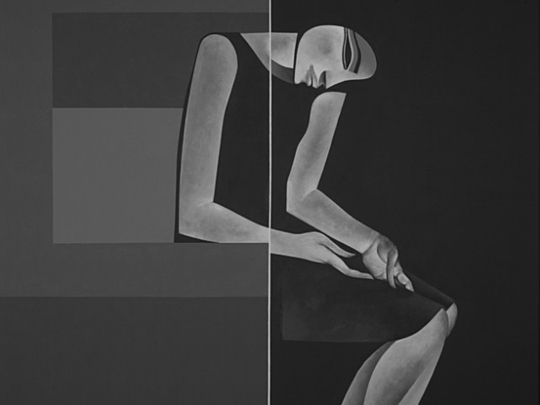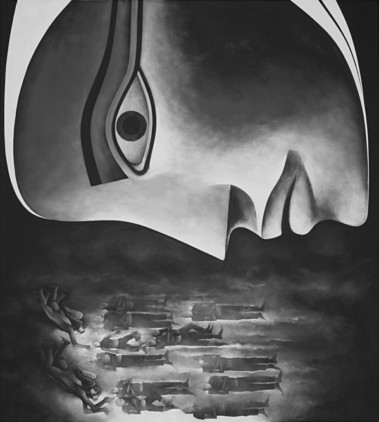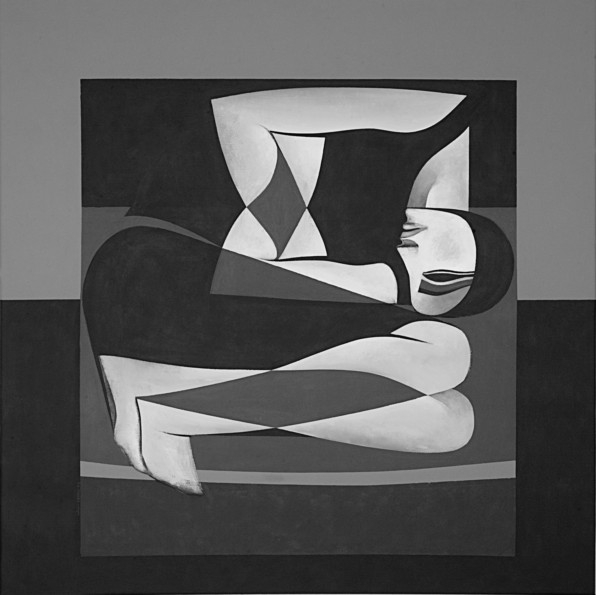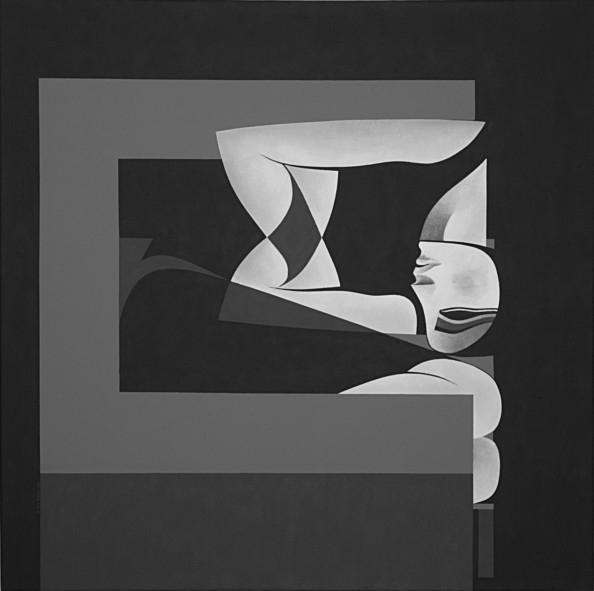
Over the past three decades Syrian artist Safwan Dahoul has narrated his experiences, feelings and thoughts through his “Dream” series. The central character in his haunting, monochromatic, minimalist paintings — all titled “Dream” — is a pensive, isolated woman, who dwells in an inner universe far away from the real world. In some of the paintings, the woman has been shown emerging from her cocoon, her wide-open eyes indicating an awareness of the reality around her. She is also depicted as a winged angel observing the world from a distance. But in his latest work, “Almost a Dream”, Dahoul’s “dreamer” is engaged directly with reality and expresses her pain and anguish about what is happening in Syria.
“Painting the ‘Dream’ series is like writing my memoirs. The woman in my paintings represents me, and she is changing because I have changed with time. Today, the reality surrounding us is so harsh that you cannot ignore it even while dreaming. In fact, the situation in Syria is so surreal that I cannot believe it is really happening. I keep questioning whether it is reality or a bad dream; and I feel embarrassed to call it a dream,” Dahoul says.
The artist moved to Dubai more than a year ago, and believes that the distance from the events in his country has given him a different perspective. “While I was in the midst of the turmoil, a part of me was not functioning. But here I can think more clearly, and have discovered new things about myself, and my emotions, which is reflected in this series. My dreams are still a source of support for me, but I have to face the reality,” he says.
This resolve to depict the stark reality is evident in his paintings. On one canvas, a shocked angel looks down at the motionless bodies of children in a moving reference to the chemical warfare, which killed many innocent children in Syria last year. In another “Dream”, the shattered face of the narrator represents the lives that have been shattered by the ongoing conflict. And she is also seen as a dying patient, with the monitor showing a fluctuating pulse eventually flattening into a straight line.
In other paintings, the woman is shown curled up in a confined space, once again retreating from the world to contemplate the bigger picture, reflecting the artist’s own state of mind. “She is scared and dejected because although she is thinking about the situation, she is helpless to do anything about it,” he says.
A triptych featuring three tonal versions of the same black, white and grey image of the sad woman is equally pessimistic. “The fading image depicts the passage of time. But the image remains the same because although times have changed, the atmosphere has changed and life goes on, sadly nothing has really changed,” Dahoul says.
The strongest and most graphic expression of his feelings is seen in a painting where the woman’s face — and the entire canvas — appears crumpled. “I wanted to create the feeling of suffocation, as if oxygen is being slowly sucked out of the atmosphere. What is happening in Syria is not ‘normal’, so in the face of this terror, destruction and grief, I am also presenting my narrator in an abnormal way. Her crumpled face and closed eyes express her feeling of resignation,” the artist says.
Jyoti Kalsi is an arts enthusiast based in Dubai.
“Almost a Dream” will run at Ayyam Gallery Dubai, DIFC, until March 13.
Box:
Reading Faces
By Jyoti Kalsi
Dubai-based Indian artist Sanjay Thapar is fascinated with faces. All the paintings in his latest show in Dubai feature portraits of various people. “When walking on the streets or travelling abroad my attention is always drawn towards interesting faces. And I have observed that even the most ordinary face has something extraordinary and unique about it. For me there is no greater joy than being able to capture that special something in every face I paint,” he says. “While painting a face I try to get inside the head of the person and view the world from their perspective,” he adds.
An interesting aspect of Thapar’s work is that he does not ever use a brush for painting. Instead, he prefers to use a nail or strips cut out from old credit cards. “Some faces are so interesting that they get etched in my memory. I saw a face like that during a recent trip to Vietnam. I used a nail to scratch out on a black background the face of the Vietnamese woman I saw on the street. The technique I have used effectively conveys the idea of a moment preserved in memory,” Thapar says.
In his colourful, textured oil paintings, the artist uses strips cut out from credit cards to apply thick strokes of paint that make the faces come alive on his canvases. “I seek to express a world beyond the confines of the canvas. I hope my viewers can see and feel the pain and pleasure that exist together in these faces, and that they will join me in celebrating both,” the artist says.
The exhibition will run at Partnership, Dubai Media City, Gateway Building A, until February 28.















